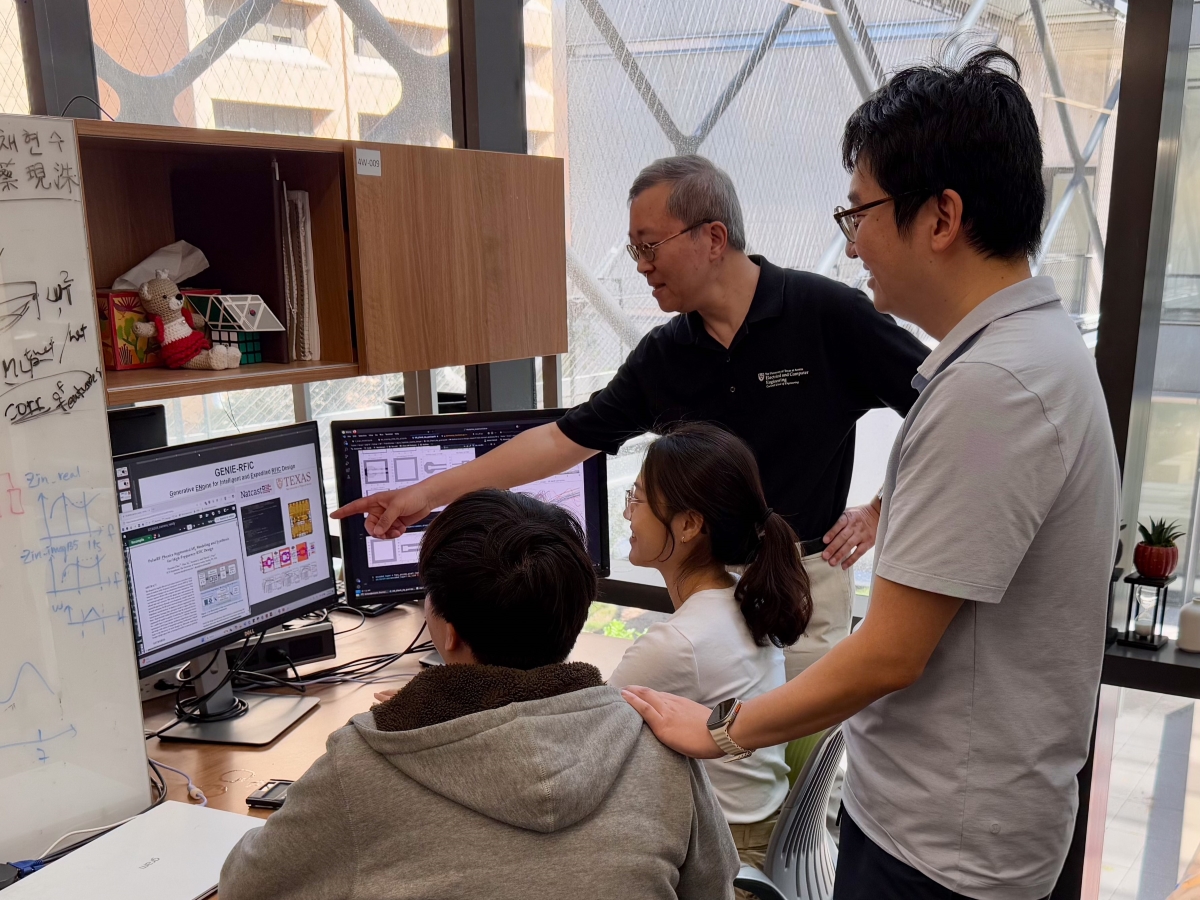Can AI Make Critical Communications Chips Easier to Design?

From left to right: Ph.D. student Song Hang Chai, post-doctoral researcher Hyunsu Chae, professor David Pan and assistant professor Sensen Li.
Radio frequency integrated circuits (RFIC) are critical to advancing communications capabilities—think moving from 5G networks to 6G—and many other technological applications. But these chips are also really hard to design.
A multi-university team with heavy involvement from industry leaders is working to change that. The team, led by researchers from The University of Texas at Austin, plans to infuse artificial intelligence into the design process for RFICs to reduce the difficulty of making these important chips.
“Design productivity is a huge problem for RFICs; in most cases, it takes at least months to design a single chip,” said David Pan, professor in the Cockrell School of Engineering’s Chandra Family Department of Electrical and Computer Engineering and the project’s principal investigator. “Our goal is to significantly enhance design productivity by reducing development time and cost through an AI-assisted design flow, while also lowering the experience barrier for performing RFIC designs.”
To support this research, the team received a $9.6 million, 30-month award from Natcast, a nonprofit that operates the National Semiconductor Technology Center (NSTC). The center is a consortium established by the CHIPS and Science Act to help bolster all aspects of semiconductor production in the United States. The award is one of three, totaling approximately $30 million, and the first ever through the NSTC’s Artificial Intelligence Driven Radio Frequency Integrated Circuit Design Enablement program. The center is a consortium established by the CHIPS and Science Act to help bolster all aspects of semiconductor production in the United States.
The Research: Titled “GENIE-RFIC: Generative ENgine for Intelligent and Expedited RFIC Design,” the project targets both silicon complementary metal oxide semiconductor (CMOS) RFICs and gallium nitride (GaN) monolithic microwave integrated circuits (MMICs). The AI-driven tools will perform rapid “inverse” designs based on target specifications, optimizing circuit topologies and parameters.
Today, RFICs require extensive hands-on design, time-consuming, expensive simulations and tedious trial-and-error work. The field is very specialized, with few researchers studying it and few companies capable of designing these chips.
The researchers aim to use AI to upend these processes, deploying the technology to probe for unconventional designs and optimize them much faster. The AI tools will speed up the early design and optimization steps. “Golden simulation,” as David Pan referred to it, would still come at the end to finalize the work and make sure the chips perform as they’re intended.
“By leveraging AI and ML technologies, U.S. companies and research institutes are poised to transform the RFIC design landscape, enabling greatly reduced design cycles and achieving higher RFIC performance,” said Marcus Pan—no relation to David Pan—program manager of Natcast’s Artificial Intelligence Driven RF Integrated Circuit Design Enablement (AIDRFIC) program which funds the GENIE-RFIC project. “This AIDRFIC investment underscores Natcast’s commitment to driving innovation and ensuring that the U.S. semiconductor sector remains at the forefront of technological advancements in broadband, 5G, and next-gen RF hardware.”
Why It Matters: RFICs are critical to everything from communications to radar to next-generation technologies like autonomous vehicles and quantum computing. By lowering the barrier to entry and speeding up the design process, RFICs could become more accessible to researchers and companies that otherwise wouldn’t have the expertise or resources to use them.
“When you can open up a key technology like RFIC to more creative minds, that can only be a good thing,” said Sensen Li, assistant professor in the Chandra Family Department of Electrical and Computer Engineering and a co-PI of the project. “It means it can be used to solve more problems and advance technological innovation that much faster.”
The Team: David Pan is joined by colleagues in electrical and computer engineering, Amy Zhang and Sensen Li, as well as Adam Klivans, professor in the College of Natural Sciences’ Computer Science Department and director of the Institute for Foundations of Machine Learning. Other academic collaborators include Dan Jiao, Purdue University; Weidong Cao, George Washington University; Kenneth O, The University of Texas at Dallas; and Taiyun Chi, Rice University.
Industry partners include IBM, Cadence, and GlobalFoundries. The researchers are developing a startup company, CircuitGenie, to commercialize technologies from this program. Several unfunded partners are contributing to the work, including: Texas Institute for Electronics, Qorvo, NVIDIA, Boeing, Texas Instruments, Analog Devices, MediaTek and more.
What Else: Training the next-generation workforce is a major part of nationwide semiconductor efforts; this project is no exception. UT Austin is starting a new master’s of semiconductor science and engineering program next fall. UT Dallas, Rice, and George Washington will develop AI-focused summer programs offering a variety of opportunities, such as AI-driven chip design camps, for K-12 and undergraduate students.
